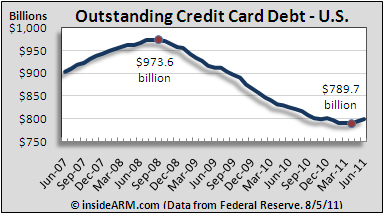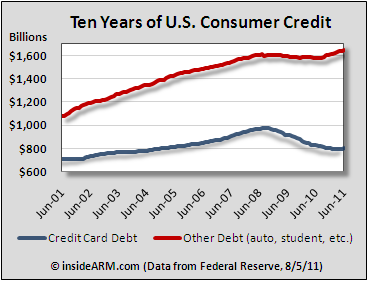Total consumer credit outstanding surged in June, according to a report released late Friday by the Federal Reserve. The gains were driven by increases in both revolving and non-revolving debt.
Credit card debt, called revolving debt by the Fed’s monthly Consumer Credit report (G.19), increased at an annual rate of 7.9 percent in June, the sharpest increase in nearly four years. Consumer credit card balances grew by $5.2 billion in June to $798.3 billion.
 June marked the second month in a row that credit card debt outstanding expanded after nearly three years of declines. A combination of soaring charge-off rates at large consumer banks, tightening of lending policies in the wake of the financial crisis, and consumers paying down outstanding credit card balances led to steady and significant drop in total card debt over the course of the past three years. Peaking at $973.6 billion in August 2008, credit card debt bottomed out at $789.7 billion in April of this year, a 23.3 percent decline over the period.
June marked the second month in a row that credit card debt outstanding expanded after nearly three years of declines. A combination of soaring charge-off rates at large consumer banks, tightening of lending policies in the wake of the financial crisis, and consumers paying down outstanding credit card balances led to steady and significant drop in total card debt over the course of the past three years. Peaking at $973.6 billion in August 2008, credit card debt bottomed out at $789.7 billion in April of this year, a 23.3 percent decline over the period.
Non-revolving debt – like that found in auto, student, and personal loans – grew at a 7.7 percent annualized rate in June. Banks added $10.3 billion in non-revolving debt in the month to stand at $1.648 trillion at the end of June. The Fed report does not include debt backed by real estate.
 Like revolving debt, non-revolving consumer debt experienced declines after the global financial crisis, but not nearly as sharp as with credit cards. From June 2008 to June 2010, non-revolving debt was down slightly, but started seeing gains last summer as U.S. consumers started buying cars again and taking out loans for higher education.
Like revolving debt, non-revolving consumer debt experienced declines after the global financial crisis, but not nearly as sharp as with credit cards. From June 2008 to June 2010, non-revolving debt was down slightly, but started seeing gains last summer as U.S. consumers started buying cars again and taking out loans for higher education.
Total consumer credit outstanding at the end of June was $2.446 trillion.




![[Image by creator from ]](/media/images/patrick-lunsford.2e16d0ba.fill-500x500.jpg)


![[Image by creator from ]](/media/images/New_site_WPWebinar_covers_800_x_800_px.max-80x80.png)
![[Image by creator from ]](/media/images/Finvi_Tech_Trends_Whitepaper.max-80x80.png)
![[Image by creator from ]](/media/images/Collections_Staffing_Full_Cover_Thumbnail.max-80x80.jpg)
![Report cover reads One Conversation Multiple Channels AI-powered Multichannel Outreach from Skit.ai [Image by creator from ]](/media/images/Skit.ai_Landing_Page__Whitepaper_.max-80x80.png)
![Report cover reads Bad Debt Rising New ebook Finvi [Image by creator from ]](/media/images/Finvi_Bad_Debt_Rising_WP.max-80x80.png)
![Report cover reads Seizing the Opportunity in Uncertain Times: The Third-Party Collections Industry in 2023 by TransUnion, prepared by datos insights [Image by creator from ]](/media/images/TU_Survey_Report_12-23_Cover.max-80x80.png)
![Webinar graphic reads RA Compliance Corner - Managing the Mental Strain of Compliance 12-4-24 2pm ET [Image by creator from ]](/media/images/12.4.24_RA_Webinar_Landing_Page.max-80x80.png)